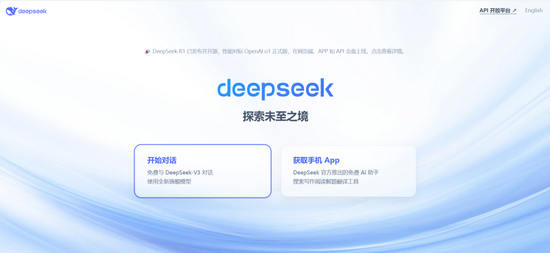DeepSeek's Take: AI's Influence on the Lifting Industry
In addition to the Spring Festival in 2025, what else has become a hot - trending topic that has gone viral? It must be DeepSeek! DeepSeek has ignited the nation's enthusiasm for AI, and people are eagerly posing all kinds of questions to it.
I also gave it a try. I decided to study DeepSeek and see if it could help answer the question "What impact will artificial intelligence have on the lifting industry?"

The following are the viewpoints given by DeepSeek after 19 seconds of "in - depth thinking" (for reference only, and the thinking process is not shown in the article).
Autonomous operation replaces manual control. AI - driven cranes can achieve autonomous lifting, obstacle avoidance, and path planning through computer vision, sensor fusion, and real - time data analysis. For example, automated quay cranes in ports can already accurately locate containers through AI algorithms, reducing manual operation errors.
Collaborative operation system. Multiple cranes work collaboratively under AI scheduling to optimize task allocation (such as the of multiple equipment at construction sites), significantly improving operation efficiency.
2. Revolutionary Upgrade of Safety Management
Real - time risk early warning. AI, combined with Internet of Things (IoT) sensors, monitors the equipment status in real - time (such as wire rope wear, structural deformation), predicts potential failures, and gives early warnings.
Behavior recognition and accident prevention. AI can identify the fatigue state or violation behaviors (such as overloading, dangerous actions) of operators through cameras and intervene in a timely manner to avoid accidents.
Unmanned high - risk operations. In dangerous scenarios such as high - temperature, high - pressure, or high - altitude environments, AI - equipped devices can completely replace humans, reducing the risk of casualties.
3. Transformation of the Maintenance Mode from "Passive" to "Active"
Predictive maintenance. AI analyzes equipment operation data (vibration, temperature, current, etc.) to predict component life and generate maintenance plans, reducing sudden downtime. For example, enterprises such as Sany Heavy Industry have already applied AI to predict mechanical failures.
Remote diagnosis and repair. Through augmented reality (AR) technology, engineers can remotely guide on - site maintenance, and even AI can directly generate repair plans.
4. Reconstruction of the Industry's Competitive Landscape
The enhancement of technical barriers. Enterprises that master the core AI technology (such as XCMG, Liebherr) will occupy a dominant position in the market, and small and medium - sized enterprises may face elimination or be forced to transform.
Innovation in service models. Shifting from "selling equipment" to "selling services", for example, the AI crane rental model that charges by the number of lifts, or providing a full - process intelligent solution.
5. Transformation of the Human Resources Structure
Job substitution. The demand for junior operators, basic dispatchers, traditional maintenance workers, and other positions is decreasing, and some work is being replaced by AI.
Emergence of new occupations
①AI system operation and maintenance engineer: Responsible for monitoring and optimizing AI crane algorithms.
②Data analyst: Mining optimization potential from equipment operation data.
③Human - machine collaboration trainer: Teaching employees how to cooperate with AI systems.
Pressure for skill upgrading. Traditional practitioners need to master digital skills (such as programming, data analysis), otherwise they will face the risk of unemployment.
6. Re - balance of Cost and Efficiency
Short - term cost increase. The research and development of AI technology, equipment upgrading, and personnel training require high - level investment.
Significant long - term benefits. By reducing labor costs, lowering accident compensation, and increasing equipment utilization rates (such as 24 - hour unmanned operation), the comprehensive benefits will far exceed the initial investment.
7. Regulatory and Ethical Challenges
Difficulties in liability definition. If an accident occurs to an AI - powered crane, the liability attribution (manufacturer, algorithm provider, or user) may trigger legal disputes.
Data security risks. Equipment operation data involves the core secrets of enterprises, and it is necessary to prevent hacker attacks or data leaks.
Employment ethics disputes. The large - scale replacement of jobs may trigger social discussions on the replacement of labor by technology.
8. Intensification of Global Competition
Technology export becomes a competitive edge. Industrial powerhouses such as China and Germany may seize the international market through AI - equipped lifting equipment.
Competition for the right to set standards. The technical standards of AI in the lifting industry (such as safety protocols, data interfaces) will become the focus of competition among countries.
Suggestions for Countermeasures
1) At the enterprise level:
①Accelerate the layout of AI technology and cooperate with technology companies to develop customized solutions.
②Establish an employee retraining system to promote the transformation of traditional job types to technical positions.
③Explore new business models of "AI + crane" (such as a shared equipment platform).
2) At the individual level:
①Take the initiative to learn digital skills (such as Python, basic machine learning).
②Transform to high - value - added positions (such as system optimization, fault diagnosis experts).
3) At the policy level:
Formulate safety standards and data supervision regulations for AI - powered cranes.
Provide subsidies or tax incentives to support the technological upgrading of small and medium - sized enterprises.
Summary
The impact of AI on the lifting industry is both a challenge and an opportunity:
Short - term pain: Reduction of traditional jobs and high costs of technological upgrading.
Long - term dividends: Leapfrog improvement in industry efficiency, sharp reduction in safety accidents, and expansion of global market opportunities.
Enterprises need to embrace change with an open mind and seize the initiative in the intelligent era through comprehensive upgrades in technology, talent, and business models.
Compared with the "Doubao AI" of ByteDance that I have been using before, the DeepSeek interface is more concise. Its distinctive feature is that it has a thinking process and can also consider directions that I haven't thought of. Finally, I personally think it is quite meaningful. Please view it prudently and treat AI objectively and rationally.
